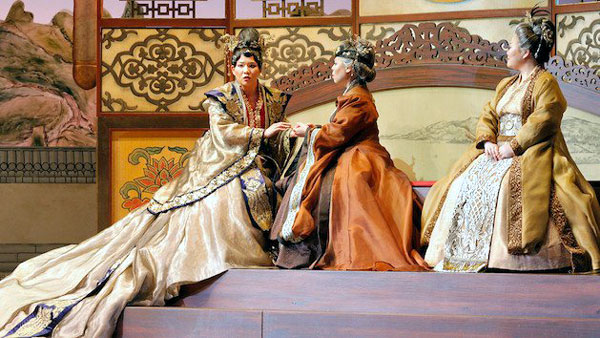|
Their brand new production, Dream of the Red Chamber, is the perfect project for San Francisco Opera. First of all, the Bay Area tends
to be culturally adventurous, so it has a good chance of supporting an original operatic work. The population of San Francisco itself is close to 40% Asian, so it’s long past
the time when we should be surprised to attend a show based on arguably the most famous work of Chinese literature. We’re fully ready for a contemporary, American,
multicultural canon, and this Chinese show is a natural addition.
To add to these, as a new opera, this project was by nature especially collaborative, just right for the recognizable thread of experimental
performance characteristic of Northern California. In fact, eminent international director Stan Lai, whose work I have followed for many years, and whose sure hand was in evidence
throughout, was even billed simply as the head of a “creative team” in some of the early promotional materials.
Already on press night, the various elements of the production had come together to form a lush, challenging web. The machinations of the 18th
century court and its rivaling wealthy families weren’t immediately easy to follow, but always managed to be exciting and suspenseful anyway. The music by Bright Sheng was
deliciously, extravagantly atonal, not perhaps the most obvious idiom for the period of the story, but with a forceful, timeless quality—one reviewer referred to Bartok and
Stravinsky—that was perfect for bridging the classical with the modern. The same can be said of the traditional gongs and cymbals we heard with the Western orchestra. The
costumes by Tim Yip were somehow both Chinese and not—opulent swirls of silk, elaborate headpieces, unexpected color combinations—but with occasional suggestions of
dress from other cultures, real or imagined.

Photo - Cory Weaver / SF Opera.
The sets (also by Tim Yip) were often like paintings come alive, reminding me of video works I’ve seen in that vein at San
Francisco’s always surprising Asian Museum. Images of a town that floated in from above broke apart and were rearranged; a
garden enclosure glided onstage; various panels were smoothly wheeled on and off. Everything in motion, cinematic. The two ill
-fated lovers wandered between stage-width layers of scrim, separated by and interconnected over vast, incomprehensible
Time. This was a truly affecting stage image: we could see how close they were to each other, but they couldn’t, or only for an instant, fleetingly.
The opera was billed as a “love triangle,” but I saw a slightly different story: two matriarchs jockeying for position, one bent
on marrying their Male Heir to a Rich Girl, the other to the Poor Girl he loves. There was no “love” of the heir (Bao Yu, sung by
Yijie Shi) for his wealthy intended (Bao Chai, sung by Irene Roberts). In fact, in the performance I saw, the two-person
scene between Bao Yu and Bao Chai served as comic relief. He had heard her praises sung, but when they were finally alone
together, she right away started in on “changing” him: he should drink his liquids warm, not cold; he should have this kind of job,
not that. The audience recognized a scold.
A more recent press angle describes the story as that of a young man who has to choose between Duty (marry the incompatible
rich girl) and Love, and this seems to me closer to what I saw. Still, I wonder if people who knew the original novel (mostly by
Cao Xueqin) had a certain advantage. For example, I was astonished when Irene Roberts took her curtain call before Hyona Kim, who played the matriarch trying to solve her
financial woes by marrying Roberts’ character into her family. The way the opera is structured now, Kim had far more stage
time and, with her complex portrayal and wondrous voice, was effectively the primary mover of the plot. But this version of Red Chamber is just one storyline extracted from an epic with
hundreds of characters, and audience members familiar with the whole were apparently making a mental adjustment, adding weight to the role of the moneyed, daughter-in-law-to-be.
Pureum Jo | Photo - Dong Xudong / Xinhua
Also requiring a viewer’s adjustment: the character of Dai Yu (Pureum Jo), the lovely, penniless cousin, was introduced as a
sickly orphan with a romantic cough—but her illness proved phantom, and she went on to sing ear-bendingly, ferociously
demanding music at magnificent volume. Of course, at the opera we know we might find, for example, the teenage Juliet sung by
an improbably large, mature diva. But in this case, the matter of Dai Yu’s fragile health seemed critical to the story at the start, and then vanished.
Co-librettists Bright Sheng and David Henry Hwang had their work cut out for them, to satisfy aficionados of the most famous
of Chinese novels, while keeping the story accessible to everyone else. In one of the advance video trailers, they both describe
balking before agreeing to join the project. In any case, the libretto is the element of this opera that will most benefit from
continued development. Firstly, the natural stress in the lines to be sung were almost always fighting with the accent in the
musical phrase. This was very tiring to the ear. Secondly, the lines had the singers communicating in Chinese-inflected
English, as if all the characters in the story sounded foreign-born to each other: a puzzling choice indeed. Still, a big part of the
pleasure of seeing a new show is knowing it will continue to take shape. The new show you are watching now may well become a classic later.

Karen Chia-ling Ho, Qiulin Zhang, and Hyona Kim | Photo - Cory Weaver/SFOpera
The singers were, of course, awe-inspiring, venturing vocally into realms fraught with difficulties and never wavering. I often wish,
at both the opera and the theatre, that there had been more time in rehearsal to bring all the performers under one roof, as it
were, so it weren’t quite so obvious that they all have widely different training. Here, too, we heard a range of techniques that
were sometimes complementary and, at others, jarring. We can continue to dream of more consistency among performers of dramas both spoken and sung. In the meantime, many a sublime
moment is achieved.
With this incarnation of Dream of the Red Chamber, San Francisco Opera and the creative collaborative artists have made
a timely contribution to both our local and international communities.
|